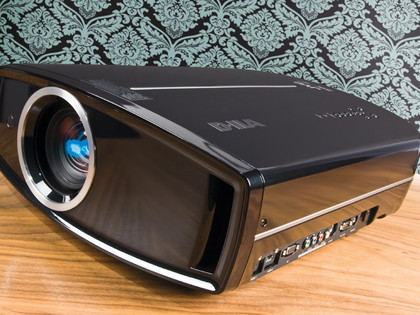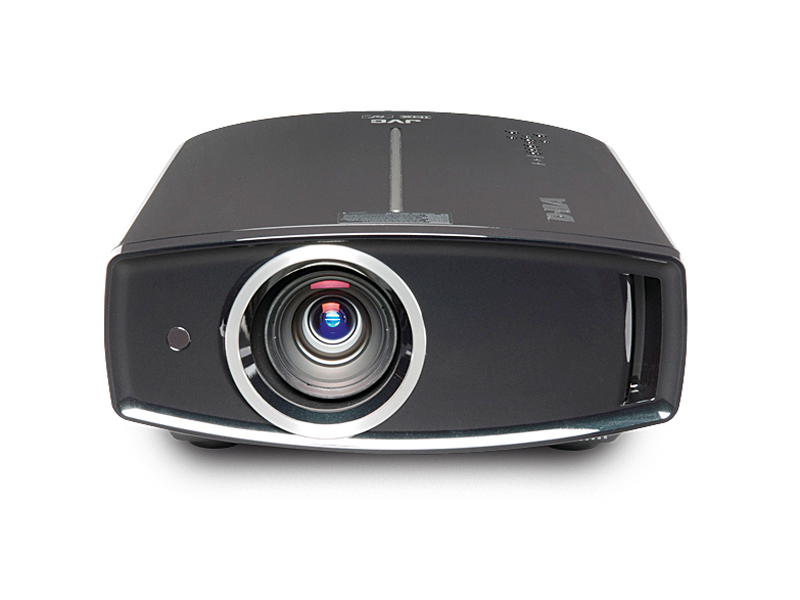TechRadar Verdict
Pros
- +
Extraordinary black levels
- +
Excellent sharpness
- +
Good design
Cons
- -
Not that bright for its price point
- -
£3.5k dearer than the HD950
Why you can trust TechRadar
To say the JVC DLA-HD950 projector is a tough act to follow is like saying The Grand Canyon is quite big. The lightbox coasted to victory as Best Projector in our recent Home Cinema Choice annual product awards, and refines the brand's already outstanding, proprietary LCOS-based D-ILA projection technology to deliver truly jaw-dropping pictures.
Remarkably, however, the HD950 is not the pinnacle of JVC's current projection range; nestled above it is the HD990. The similarities between the two models suggest that the HD990 is only an incremental improvement on the HD950. Yet the price gap is a rather non-incremental £3.5K. So clearly we will be focusing on whether the HD990 is sufficiently better to justify such a price hike.
We asked JVC's product specialist manager, Steven Carter, to give us JVC's own take on the HD990. For a start, why bother with it?
"Because we could", says Steven. "We were going through the selection process for the HD950's components, and we could see that the top 2 per cent of the optical systems we were producing were delivering amazing quality. So we thought we'd build a dedicated projector out of this 2 per cent and offer it to the consumer. Especially as consumers have been requesting a higher end unit over and over again.
"We're not just talking about the D-ILA device here," Steve continues. "In creating a 990 we take the best of the lenses, the best of the optical engines, the best of the optical devices [JVC's Optical Wire Grid system], and the best processing performance. And as long as they all work together to produce optimum quality, that's when we end up with an HD990."
To be more specific, the HD990 offers a claimed contrast ratio of 70,000:1 versus the 50,000:1 of the HD950. That's a truly substantial increase of nearly 40 per cent, which becomes even more potentially significant when you realise these figures are all native, rather than conjured up using a dynamic iris.
Non-identical twins
As you can probably guess from the 'top 2 per cent' criteria mentioned earlier, the HD990 is a relatively niche product compared with the HD950, aimed at the custom install market and clients who want the best, more or less regardless of cost.
Aesthetically, the HD990 initially looks identical to its predecessor, which isn't a bad thing, since it finds the projector sturdily built and sporting an extremely glossy black finish. The only cosmetic touch to distinguish this lightbox from its sibling is a silver D-ILA logo emblazoned on the upper edge.
It's extremely likely, of course, that anyone buying an HD990 will have it professionally installed. But whoever does that installation should have a pretty easy time. For instance, the projector supports a prodigious x2 optical zoom, supported by motorised optical image shifting in both the vertical and horizontal planes.
Four simple screw-down legs help you tweak any small angle issues you might have with your final image, while final focusing is also achieved via the remote, with decently fine degrees of adjustment. The onscreen menus are appealingly businesslike in their presentation, meanwhile, and mostly well organised. And, unlike some of JVC's earlier D-ILA projectors, the HD990 doesn't skimp on its fine-tuning tricks.
An essential tool at this high end of the market is a neatly presented colour management system that enables you to adjust the hue, saturation and brightness of all six of the main video colour components and stores the results into one of three memory slots.
You can also adjust the projector's block noise reduction, mosquito noise reduction and general noise reduction routines individually, switch in colour transient improvement circuitry, select from multiple colour temperature presets (including 6500K), and either choose a gamma preset, or arrive at your own gamma preference by adjusting the white, red, green and blue parts of the picture at any of 12 points along the traditional gamma curve. Among the picture presets is a worthwhile one calibrated by the THX group.
Finally, although the HD990 doesn't use a dynamic iris, it does let you manually adjust the lens aperture to fine-tune brightness based on the demands of your viewing room.
Separated at birth
So, are the HD990's pictures significantly better than those of the already exceptional HD950?

Well, they're certainly noticeably better, which is no mean feat given the latter's quality. The most obvious performance difference can be seen during dark scenes. The blackness of the backdrop to the space battle at the start of The Revenge of the Sith looks a couple of shades deeper than it does on the cheaper stablemate. And crucially this is achieved without simultaneously reducing shadow detailing.
In fact, with stars and other bright points in the image retaining their brightness to at least the same degree as the HD950, the perception - if not the reality - is that there's actually more shadow detail.
I was surprised and pleased to note that the HD990's advantages don't end with its contrast. For its picture is also slightly crisper and brings fractionally more definition to favourite Blu-ray sequences such as the scenes outside Bond's mountain-top hospital in Casino Royale.
Adding to this sense of marginally boosted, but natural, sharpness is the way JVC's Clear Motion Drive processing seems slightly better. The extra fluidity the system adds feels roughly the same, but the amount of artefacting (chiefly shimmering haloes around moving objects) looks slightly reduced, at least using the Drive's low setting.
One final area of improvement lies with the colours, which are richer and more natural during dark scenes. The HD990's incremental improvements (or more, in the case of black level response) produce the finest projection picture I've seen for under 10K. Its naturalism, dynamism and sharpness are stunning, making even the most routine of films or games a joy to behold.
What's more, the HD990 produces its exemplary images while generating remarkably little running noise. Even when sitting right next to it, I could barely hear a thing. If I had to find an excuse to spend more money, I'd say the HD990 isn't a high-brightness 'light cannon' such as the sort of machines produced by Sim2 and Runco, costing in excess of £10K.
So it's a little more limited regarding the screen size it can drive and the amount of ambient light it can contend with. The bottom line with the HD990 is that it succeeds in making one of the best projectors we've ever seen appreciably better and that's all we could fairly expect.
You could also argue that the HD990's small but numerous improvements might not quite add up to £3.5k's worth of difference between it and the HD950. But I'd argue that if you're lucky enough to be able to consider stepping up from £5.5k to £9k, matters of quality are likely much more important to you than mere financial concerns.
The bottom line with the HD990 is that it succeeds in making one of the best projectors we've ever seen appreciably better.
Follow TechRadar Reviews on Twitter: http://twitter.com/techradarreview
John has been writing about home entertainment technology for more than two decades - an especially impressive feat considering he still claims to only be 35 years old (yeah, right). In that time he’s reviewed hundreds if not thousands of TVs, projectors and speakers, and spent frankly far too long sitting by himself in a dark room.

